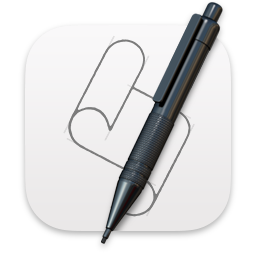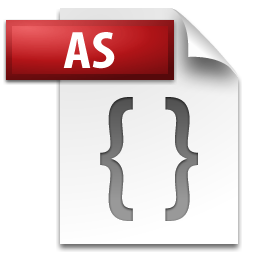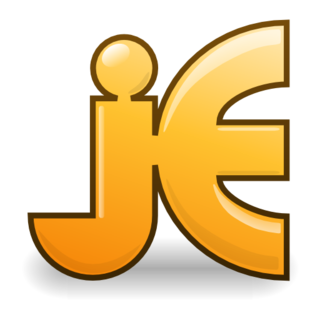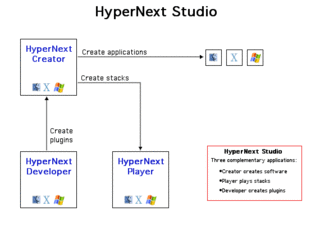
An integrated development environment (IDE) is a software application that provides comprehensive facilities to computer programmers for software development. An IDE normally consists of at least a source code editor, build automation tools and a debugger. Some IDEs, such as NetBeans and Eclipse, contain the necessary compiler, interpreter, or both; others, such as SharpDevelop and Lazarus, do not.
Adobe Flash is a deprecated multimedia software platform used for production of animations, rich Internet applications, desktop applications, mobile applications, mobile games and embedded web browser video players. Flash displays text, vector graphics and raster graphics to provide animations, video games and applications. It allows streaming of audio and video, and can capture mouse, keyboard, microphone and camera input. Related development platform Adobe AIR continues to be supported.

Vim is a clone, with additions, of Bill Joy's vi text editor program for Unix. Vim's author, Bram Moolenaar, based it upon the source code for a port of the Stevie editor to the Amiga and released a version to the public in 1991. Vim is designed for use both from a command-line interface and as a standalone application in a graphical user interface. Vim is free and open-source software and is released under a license that includes some charityware clauses, encouraging users who enjoy the software to consider donating to children in Uganda. The license is compatible with the GNU General Public License through a special clause allowing distribution of modified copies "under the GNU GPL version 2 or any later version".
VBScript is an Active Scripting language developed by Microsoft that is modeled on Visual Basic. It allows Microsoft Windows system administrators to generate powerful tools for managing computers with error handling, subroutines, and other advanced programming constructs. It can give the user complete control over many aspects of their computing environment.
In computing, cross-platform software is computer software that is implemented on multiple computing platforms. Cross-platform software may be divided into two types; one requires individual building or compilation for each platform that it supports, and the other one can be directly run on any platform without special preparation, e.g., software written in an interpreted language or pre-compiled portable bytecode for which the interpreters or run-time packages are common or standard components of all platforms.

AppleScript is a scripting language created by Apple Inc. that facilitates automated control over scriptable Mac applications. First introduced in System 7, it is currently included in all versions of macOS as part of a package of system automation tools. The term "AppleScript" may refer to the language itself, to an individual script written in the language, or, informally, to the macOS Open Scripting Architecture that underlies the language.

FileMaker Pro is a cross-platform relational database application from Claris International, a subsidiary of Apple Inc. It integrates a database engine with a graphical user interface (GUI) and security features, allowing users to modify the database by dragging new elements into layouts, screens, or forms.
In computing, an icon is a pictogram or ideogram displayed on a computer screen in order to help the user navigate a computer system. The icon itself is a quickly comprehensible symbol of a software tool, function, or a data file, accessible on the system and is more like a traffic sign than a detailed illustration of the actual entity it represents. It can serve as an electronic hyperlink or file shortcut to access the program or data. The user can activate an icon using a mouse, pointer, finger, or recently voice commands. Their placement on the screen, also in relation to other icons, may provide further information to the user about their usage. In activating an icon, the user can move directly into and out of the identified function without knowing anything further about the location or requirements of the file or code.

ActionScript is an object-oriented programming language originally developed by Macromedia Inc.. It is influenced by HyperTalk, the scripting language for HyperCard. It is now an implementation of ECMAScript, though it originally arose as a sibling, both being influenced by HyperTalk.

Macintosh Programmer's Workshop or MPW, is a software development environment for the Classic Mac OS operating system, written by Apple Computer. For Macintosh developers, it was one of the primary tools for building applications for System 7.x and Mac OS 8.x and 9.x. Initially MPW was available for purchase as part of Apple's professional developers program, but Apple made it a free download after it was superseded by CodeWarrior. On Mac OS X it was replaced by the Project Builder IDE, which eventually became Xcode.

jEdit is a free software text editor available under the GNU General Public License version 2.0. It is written in Java and runs on any operating system with Java support, including BSD, Linux, macOS and Windows.

BBEdit is a proprietary text editor made by Bare Bones Software, originally developed for Macintosh System Software 6, and currently supporting macOS.
A user interface markup language is a markup language that renders and describes graphical user interfaces and controls. Many of these markup languages are dialects of XML and are dependent upon a pre-existing scripting language engine, usually a JavaScript engine, for rendering of controls and extra scriptability.

Quartz Composer is a node-based visual programming language provided as part of the Xcode development environment in macOS for processing and rendering graphical data.

Google Web Toolkit, or GWT Web Toolkit, is an open-source set of tools that allows web developers to create and maintain JavaScript front-end applications in Java. Other than a few native libraries, everything is Java source that can be built on any supported platform with the included GWT Ant build files. It is licensed under the Apache License 2.0.

HyperNext is a visual software development system aimed at beginner programmers that runs on Macintosh and Windows computers. It was inspired by HyperCard and includes a GUI having controls such as buttons and listboxes, and an interpreted English-like programming language. HyperNext also includes a high-level object-oriented compiled BASIC. The HyperNext Studio package comprises three complementary applications that can help users create and run software under Windows and Mac OS X and Mac OS 9 platforms:
- HyperNext Creator is similar to Hypercard and enables users to create their own software, both cross-platform standalone applications and stacks for the freeware HyperNext Player. The design interface of Creator has just a design window, one toolbar and a mode switcher. Its three modes of Design, Preview and Run enable rapid switching between the creation/editing and running of programs.
- HyperNext Developer builds plugins/libraries for HyperNext Creator and allows users to extend the functionality of Creator with their own or 3rd party plugins. HyperNext Developer has a very similar user interface to that of Hypernext Creator and places built plugins directly into the Creator's plugin folder. For faster plugin development is possible to have both Creator and Developer open simultaneously.
- HyperNext Player is a standalone application similar to Hypercard Player in that it runs stacks created by its creator application, HyperNext Creator. HyperNext Player is freeware and there are versions for Windows and Mac OS X and Mac OS 9 platforms.

Adobe Director was a multimedia application authoring platform created by Macromedia and managed by Adobe Systems until its discontinuation.
A scripting or script language is a programming language for a special run-time environment that automates the execution of tasks; the tasks could alternatively be executed one-by-one by a human operator. Scripting languages are often interpreted.

Hollywood is a commercially distributed programming language developed by Andreas Falkenhahn which mainly focuses on the creation of multimedia-oriented applications. Hollywood is available for AmigaOS, MorphOS, WarpOS, AROS, Windows, macOS, Linux, Android, and iOS. Hollywood has an inbuilt cross compiler that can automatically save executables for all platforms supported by the software. The generated executables are completely stand-alone and do not have any external dependencies, so they can also be started from a USB flash drive. An optional add-on also allows users to compile projects into APK files.









